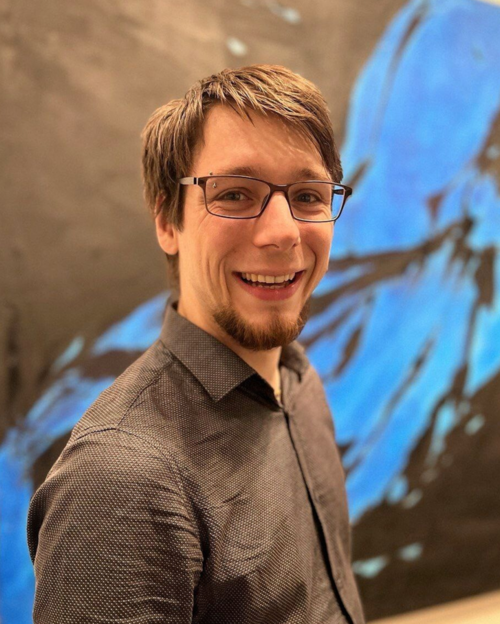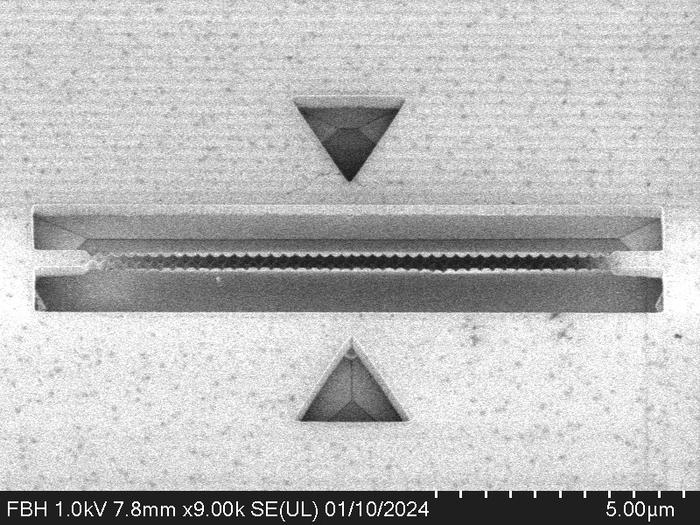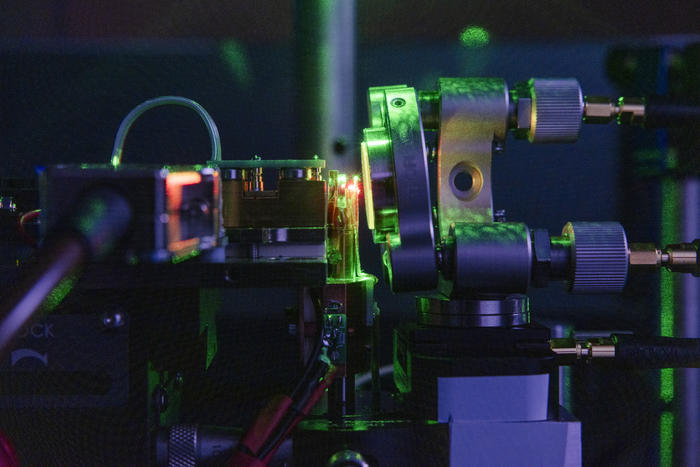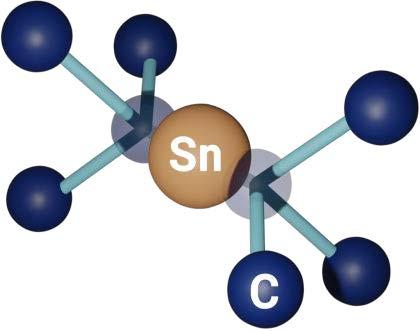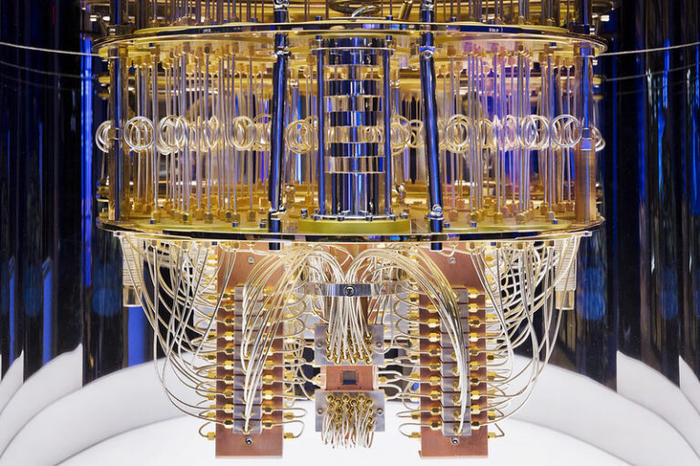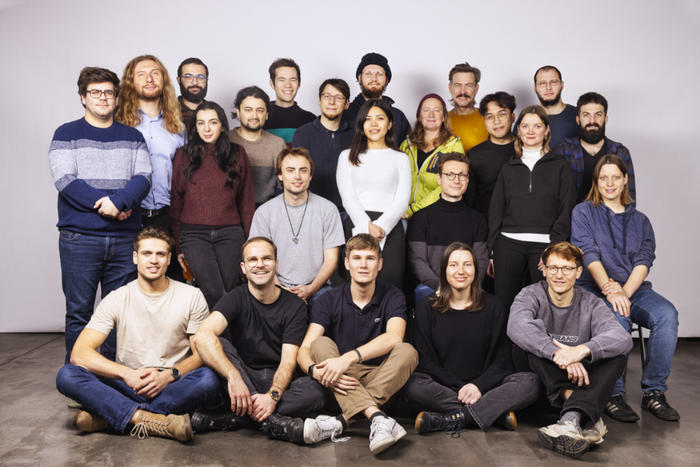Quantum light meets diamond – inspired by the sawfish
Marco Stucki is one of the five winners of our “Art Meets Science” ideas competition. He won in the category of quantum technologies—one of the major transformative topics of our time.
At the Ferdinand Braun Institute, Marco Stucki is developing tiny diamond structures that help store and transmit quantum information—a potential building block for the computers of the future.
Quantum computers are considered the key technology of tomorrow. They promise a revolution in information processing; the United Nations has even declared 2025 the International Year of Quantum Science and Technology. But there is still a long way to go: qubits, the basic units of information in a quantum computer, are extremely susceptible to interference. Technical control over many qubits simultaneously is complex, and the loss-free transmission of quantum information also poses major challenges for research.
This is precisely where Marco Stucki and his research group come in: in the applied field of quantum information processing, they are developing novel material platforms that can be used to generate, manipulate, and transmit qubits. At the heart of their work is the Sawfish Cavity – an optical resonator with a wave-like structure that can efficiently amplify light and guide it into optical fibers in a targeted manner. The name is inspired by the distinctive nose of a sawfish.
What makes it special is that the entire structure is made of the hardest material in the world – diamond. Electron beams and plasma technology are used to create tiny nanoscale components that could one day play a central role in quantum communication systems.
In this interview, Marco talks about the challenges of working with diamond, about luminous color centers, quantum bits, and why we probably won't be carrying quantum computers in our pockets anytime soon – but why they could still change our world.
3D artist Hannelore Braisch has interpreted Marco's research: diamonds and networks of quantum light at Kottbusser Tor. The background: quantum states can be sent as red light particles — the basis of quantum communication.
Dear Marco, congratulations on winning the BUA ideas competition in the field of quantum physics. What motivated you to take part in the competition?
In addition to research itself, I see science communication as one of the main tasks of a scientist. Research is not only conducted out of self-interest or for possible industrial applications. Science is a cultural asset and, as such, should be made accessible to our fellow human beings. Presenting research through art makes it possible to break down complex relationships and present them in a visually appealing and exciting way. When I heard about the “Art Meets Science” ideas competition, I saw it as a unique opportunity to communicate my research to the public.
Your project is called Sawfish Cavity – named after the nose of a sawfish. How did you come up with this name, and what is the significance of this particular structure?
In our context, a cavity is an optical resonator. Resonators can trap light in a small area and amplify it. They are indispensable components for optical experiments and many technical applications. The most straightforward way to build them is by placing two mirrors opposite each other. When light enters between these mirrors, it is reflected back and forth repeatedly and is trapped between the mirrors for a time until it is either absorbed or escapes from the two mirrors. If more light enters the cavity than escapes, the intensity of the light between the two mirrors increases.
With the Sawfish Cavity, our research group has designed a new resonator structure that exhibits good properties compared to already established cavity structures. In addition, we can use it to transmit light with low loss, e.g., into a fiber optic cable.
Electron microscope image of a Sawfish Cavity: Top view of the tiny diamond structure. The design and simulation are by Julian Bopp, and it was manufactured by Marco Stucki.
In the hope that the wider research community would try out our structure, we wanted to find a name that would be easy to remember. The nose of the sawfish is reminiscent of the wave-like pattern of our structure. The name is short, snappy, and sticks in your mind.
You work with diamonds on a nanoscale—how can we imagine that?
Our cavity is about one hundredth of a millimeter long, but ideally only 20 millionths of a millimeter wide. If you were to shrink the entire city of Berlin to the width of a human hair, the width of the cavity would be about the size of the ball on the TV tower. Working with diamonds on this scale is an additional challenge because it is the hardest material in the world and can only be scratched by another diamond. Chemically, diamonds are non-reactive, so strong acids and bases cannot damage them.
How do you create such small structures in such a hard material?
With plasma. We use technologies developed by the semiconductor industry to manufacture microchips. Put simply, we apply a kind of lacquer to the diamond.
To transfer our structure onto the lacquer, we use a focused electron beam. The lacquer is weakened where the beam hits and can then be removed with a solvent. This allows us to draw any pattern we want in the lacquer. The result is a mask directly on the diamond that now depicts a top view of the sawfish cavity. This mask selectively protects the diamond when we place it in a plasma furnace, where the unmasked surface is burned in a controlled manner. We have now transferred our Sawfish structure to the diamond, followed by a couple of plasma etching and coating steps to separate the structure from the diamond substrate. The finished structure ultimately overhangs like a bridge.
How do these tiny structures help to store or send quantum information?
The quantum systems we are interested in exist in diamonds: the so-called color centers. These are specific arrangements of atoms that allow us to store and manipulate quantum information.
A color center in a diamond: In this so-called tin vacancy, a tin atom (Sn) sits between two missing carbon atoms (transparent spheres) in the diamond lattice. The blue spheres are the surrounding carbon atoms (C) of the diamond.
We can compare them to the bits in classical computers, i.e., memory locations that contain 1 or 0. Color centers are our quantum bits, or qubits for short. A great feature of qubits is that they can also assume states between 1 and 0, e.g., 25% 1 and 75% 0.
Another great property of color centers is that they can emit their quantum state (1 or 0 or something in between) as a single light particle. This light particle is red in color and can be guided into a glass fiber and thus sent. This is quantum communication.
As impressive as the properties of these color centers are, unfortunately they are still far from sufficient for efficient computing or information transfer. To improve this, we build structures around the color centers. This is where the Sawfish Cavity comes into play. A single color center is placed in the middle of the cavity. The cavity then improves the properties of the color center and allows us to efficiently capture the light particle and transmit it via fiber optics.
Quantum computers are considered a technology of the future. When and how will they become noticeable in our everyday lives?
Quantum computers are on their way. Many outstanding scientists around the world are researching them and repeatedly demonstrating their progress with impressive experiments.
In early 2019, IBM unveiled the first commercially viable quantum computer—i.e., one that can be used outside of laboratory environments — the IBM Q System One. Credit: IBM Research
Personally, however, I don't think we will feel the effects of quantum computers in everyday life in the next ten years. So far, no existing quantum computer is powerful enough to compete with a conventional computer. The problem is that the quantum states we want to control are incredibly fragile and therefore prone to interference. A few qubits can be controlled well, but with millions of qubits, it's a phenomenal challenge. So scalability is an issue.
The second question is how quantum computers will be noticeable in everyday life once they are here. Many people think that we will then carry quantum computers in our pockets or that the new gaming computer will be based on quantum technology. It is possible that quantum computers will be used by everyone, just like classic computers, but this is not foreseeable at present.
Although quantum computers can do everything that classic computers can do and more, the extra capabilities of quantum computers come with a technical overhead. This means that standard calculations are much slower on quantum computers.
Quantum computers are not faster classical computers—they enable entirely new methods of computation. For example, in the development of new drugs, they could solve problems that today's computers fail to solve.
The advantages of quantum computers therefore lie not in higher processor speeds, but in the fact that they enable completely new computing methods that are fundamentally inaccessible to classical computers. This allows for new computing algorithms that can solve very large problems more efficiently and thus more quickly.
This means that for standard calculations, which a classical computer can also solve well, it will probably never be worthwhile to use a quantum computer. But in the development of new drugs, for example, we could benefit from the computing power. Similar to the early days of transistors, it is still difficult to predict what possibilities powerful quantum computers will open up for us in the future.
You come from Switzerland, but Berlin is your research home. How do you experience the Berlin research landscape?
Compared to Zurich, Berlin is of course much bigger. There are many free offers specifically for doctoral students. For example, I have already taken part in a writing course, a three-day PhD retreat, and next week I am doing a workshop on 3D modeling.
The Integrated Quantum Photonics working group, led by Prof. Dr. Tim Schröder, conducts research at HU Berlin and the application-oriented Ferdinand Braun Institute at the interface between quantum physics and quantum technology.
Despite Berlin's size, however, much of what is important to me takes place just outside the city, on the huge Adlershof Science Campus. In addition to the Physics Department at Humboldt University and the Ferdinand Braun Institute, where I am doing my doctorate in Prof. Tim Schröder's research group, there are many research institutes and high-tech companies located in a small area here. This geographical proximity promotes collaboration.
In addition to the city's scientific significance, Berlin's lively art scene enables exciting and inspiring synergies. I have already participated in events focusing on quantum art—a topic that naturally fascinates me in particular.
Dear Marco, thank you for the interview!
Find out more about quantum research at the Ferdinand Braun Institute.
Click here to visit the Integrated Quantum Photonics Group at HU Berlin.

